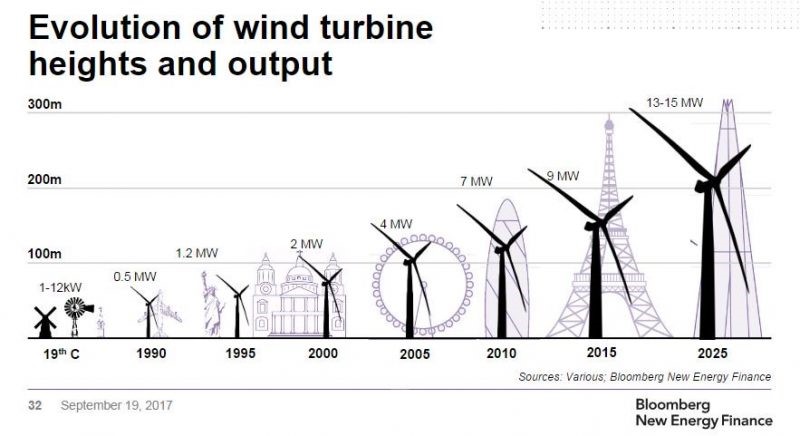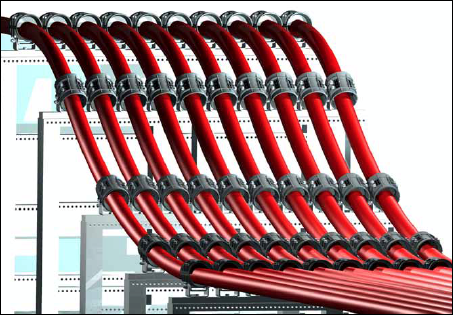With concerns over climate change and fossil fuel security, the world is seeing a significant shift toward renewable energy sources. By 2040, it is expected that renewables could account for 30% of the world’s electricity supply. Here in Europe, that could be as high as 50%. One area of renewables which has seen significant growth & development is wind energy. In the last 30 years, both onshore and offshore wind capacity have seen huge growth and the technology has developed at a fast pace. In fact, the latest turbine models produce 25,000 times as much power compared to the turbines used in the first ever commercial offshore wind farm 30 years ago.  The cost of producing energy from wind is falling and relative to other sources, offers a viable renewable alternative. The cost of offshore wind has plummeted by almost 30% in the last two years and when compared to the future Hinkley Point C nuclear power station, costs just £40/MWh versus Hinkley’s expected £92.50. This is an international trend too. Globally, the portfolio of offshore wind projects rose 15% in 2019. Whilst Europe remains the largest single region, with significant installed capacity in the UK, Denmark, Germany & the Netherlands, there are significant project pipelines across North America & Asia. As a world leader in the design & manufacture of cable cleats, Ellis has been involved in ensuring safe cable installation practice on major windfarm projects across the globe. We’ve worked closely with operators, OEMs, EPC companies, cable manufacturers & cable installers, to ensure that we offer the best solution for their requirements. As always, Ellis’ greatest concern is to ensure that cable cleats are correctly specified to cope with the short circuit withstand requirements of the project. The formula below, taken from the International standard IEC 61914, can be used to calculate the forces between two conductors in the event of a three phase fault: Ft = 0.17 x ip2 / S Where: Ft = force in Newton/metre (N/m) ip = peak short-circuit current in kiloamps (kA) S = distance between the centrelines of the conductors in metres (m) Once Ft, in N/m, has been determined then the force for each potential cable cleat can be calculated. You can learn more about correctly specifying cable cleats here. When it comes to wind farm projects, there are often other considerations in addition to the usual short circuit concerns;
The cost of producing energy from wind is falling and relative to other sources, offers a viable renewable alternative. The cost of offshore wind has plummeted by almost 30% in the last two years and when compared to the future Hinkley Point C nuclear power station, costs just £40/MWh versus Hinkley’s expected £92.50. This is an international trend too. Globally, the portfolio of offshore wind projects rose 15% in 2019. Whilst Europe remains the largest single region, with significant installed capacity in the UK, Denmark, Germany & the Netherlands, there are significant project pipelines across North America & Asia. As a world leader in the design & manufacture of cable cleats, Ellis has been involved in ensuring safe cable installation practice on major windfarm projects across the globe. We’ve worked closely with operators, OEMs, EPC companies, cable manufacturers & cable installers, to ensure that we offer the best solution for their requirements. As always, Ellis’ greatest concern is to ensure that cable cleats are correctly specified to cope with the short circuit withstand requirements of the project. The formula below, taken from the International standard IEC 61914, can be used to calculate the forces between two conductors in the event of a three phase fault: Ft = 0.17 x ip2 / S Where: Ft = force in Newton/metre (N/m) ip = peak short-circuit current in kiloamps (kA) S = distance between the centrelines of the conductors in metres (m) Once Ft, in N/m, has been determined then the force for each potential cable cleat can be calculated. You can learn more about correctly specifying cable cleats here. When it comes to wind farm projects, there are often other considerations in addition to the usual short circuit concerns;
When installing cables in the turbine tower, cable weight and the corresponding axial force on the cleat must be considered. By design, some cleats offer a greater axial load capability than others and therefore lend themselves more favourably to vertical installations. Ellis has the most extensive range of cable cleat designs on the market and as such, has a range of offerings suitable for vertical installations from stainless steel to polymeric products. With onsite facilities, we can offer testing to specific project requirements in addition to the IEC guidelines.
On a range of projects, installation space can be crucial. For wind farms, this could be an issue in the nacelle or inside the tower. No two Ellis cleats look the same, offering the client a range of choices for installations. For example, the Ellis Vulcan+ cleat has a very narrow design, meaning space between cable runs can be minimised. Equally important, the Ellis Emperor cleat offers a low profile design where available headroom is an issue.
On offshore windfarms in particular, large HV cables have to take lengthy and complex routes. In locations such as the Modular Offshore Grid (MOG), similar to large offshore substations, installers require an efficient, safe and cost-effective method to install their cables. Ellis can offer Cable Guide Clamp – a product specifically designed for an offshore project. This product offers a dual function as both a guide, eliminating the need for rollers, and a clamp. Designed with ease of installation at its core, Cable Guide Clamp is manufactured from a low friction polymer and offers a trumpet-like appearance to reduce contact surface area with the cable during pulling.  The wind sector will continue to grow, with a worldwide pipeline of projects already in the wings. The development of floating wind turbine technology will also open up opportunities for deep-water areas, where fixed turbines are not feasible. With an international network of distributors, Ellis cable cleats are tried, tested and trusted to safely secure cable on the world’s largest power & infrastructure projects. Please contact us for more information. References: The Guardian, 2019 Renewables UK, 2019 OVO Energy, 2018 BBC, 2019 Bloomberg, 2017
The wind sector will continue to grow, with a worldwide pipeline of projects already in the wings. The development of floating wind turbine technology will also open up opportunities for deep-water areas, where fixed turbines are not feasible. With an international network of distributors, Ellis cable cleats are tried, tested and trusted to safely secure cable on the world’s largest power & infrastructure projects. Please contact us for more information. References: The Guardian, 2019 Renewables UK, 2019 OVO Energy, 2018 BBC, 2019 Bloomberg, 2017